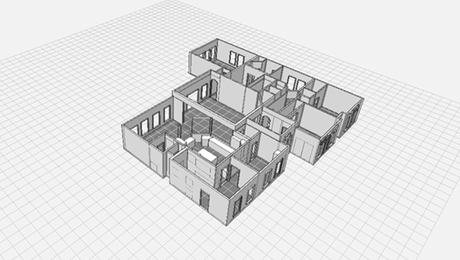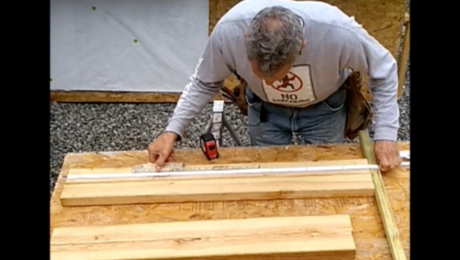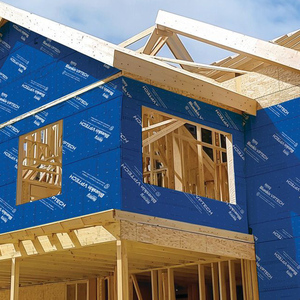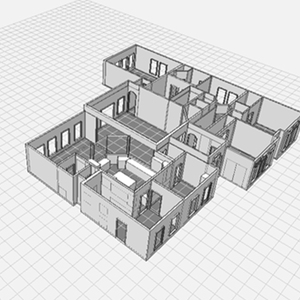Hi guys,
First post here, just a reader so far.
I’m planning on going with a crawlspace foundation. At first, I was thinking 3 to 5 courses (24 to 40 inches) of concrete block on top of the footing. The more I thought about it, I figured if we go 40 inches, well, what’s to keep going and go for a full basement other than a lot more labor.
I’m in Northern California, so contructing for seizmic activities is required. Plans aren’t set in stone yet, but, if we go with a full basement (6-7 feet below ground, 2-3 above), horizontal and vertical rebar probably every 2 feet, with the verticals being embedded into the footing to tie it all together.
This will be our first crack at concrete “block” construction, so I’m curious as to the fill being used. I’ve read a number of different articles, forum discussions, etc on the subject, but still have a couple questions.
Most people refer to using grout to “fill” all reinforced cells. Some use a concrete (pea gravel mix) fill. Are people using grout because….it’s cheaper? easier? stronger? can be mixed on site, so no need to rush by having a cement truck there? My first thoughts would lead me to believe a concrete fill would be stronger than a grout fill, but I could be wrong (it happens all the time).
Would anyone care to shed some light on the topic? I’ve searched through the threads, but could not find one on this specific topic (grout versus cement fill).
Thanks in advance.



















Replies
You sound like a good candidate for ICFs. You are already investing in the steel so why not consider an insulated joint free basement? If this is a DIY project they sure are a lot faster and easier than block, prehaps even cheaper.
Pete,I have looked into those somewhat, probably not enough, but mostly from reading about people doing those. I have yet to see an install in person, so I guess that makes me kind of hesitant. 2nd, from what I have seen (in ads, articles, websites), there seems to be quite a variety of systems out there, and probably even more salespitches about which system is better than the other, etc. I know concrete blocks have been used for sometime now and I feel pretty confident about that type of setup (when done properly). Thanks for the input, I will look into those more though. By the way, do you have a particular ICF system you're in favor of?
I use Polysteel for two main reasons, a close distributor and I like the metal web to screw things to instead of the plastic.I'm sure other brands perform just fine.I just have used nothing else for basements for the last 10 years. I'd love to try a whole house of ICFs but haven't had anyone interested yet. They are still something new but in climates that require and insulation they have to gain in popularity.
Pete,Good info. I checked out their site. I like their PolyPro version, since it's expandable. After 10 years, yeah I guess you do like them. You commented about popularity....out here full basements are rare, and that's probably one reason why they haven't caught on too well. Thanks for the info!
If you have a bunch of time on yours hands or some strong backs who don't mind humping buckets of mud from the mixer you could do it on site.
We usually order the pump mix and the pumper to go along with it and get it over with.
Ralph,I was thinking about that (all the backwork and probably slowww progress) by mixing onsite. If you don't mind me asking, what kind of mix are you using to fill cells?Also, are you pouring in 4-5 foot lifts (which I keep reading is recommended)? All 8 or 9 feet at one time? 4 or 5 feet as you work your way around the walls and then come back to to where you started and continue up from there? Vibrate in between?Thanks.
If I don't specify a strength and just order a pump mix I'll be getting peastone at about 2500psi. The slump is about a 5 which to me is a little soupy but the pump operators love it.
The pump operator will snake out his hose to the far side of the job and work backwards from there. Every cell that is to be filled is topped off as he backs up. Most of the time we rod the cells. As I said, the mix tends to be loose and just flows right in. The top course is set with lintel blocks so a #5 bar can be run around the top and a barrier is placed two courses down so you get a bond beam that is two courses thick (all cells filled). The vertical rebar is set every four feet, every corner and on each side of an opening. It's tied to rebar that's left two feet out of the initial footing pour and bent and tied to the bond beam rebar. No one pumps cells in lifts. It's just one vertical slug of concrete every four feet that does not exert the pressure that would occur if you were pouring a solid stem wall or pouring ICF's.
After rodding and when the pumper is out of the way we strike off the overflow, set any bolts and call it a day.
Inspector requires a knockout block on the bottom course at each vertical location so he can see the tie off. Tapcon a piece of plywood over the opening before the pour.
Ralph,Thanks for the info on the mix and rebar placement. One thing I'm curious about is if these are full basements you're referring to or completely above ground walls? I ask because you mentioned the vertical rebar on the corners and on each side of openings (I assumed windows and doors). If full basements (with most of the wall below ground level), do you worry about only filling the verticals every 4 feet, versus every cell? I'm just thinking about lateral pressure from backfill down the road. Maybe I'm thinking overkill in planning on filling every cell.
I don't have formal education in concrete, but in my experience when one speaks of "grouting" hollow concrete block the "grout" is concrete, made with stones that flow well (such as pea gravel), mixed a little on the loose side so it can flow and fill up the cavities with just the force from plopping it in from above. It is not the same as grout used in filling the joints in ceramic tile.
For seismic strength I'd imagine you'd need horizontal reinforcement too, such as dur-a-wall every course or two. Poured concrete would be much stronger. Hardly anyone uses concrete block anymore.
Hardly anyone uses concrete block anymore. I do, I filled 100% of my block with 8000lb psi place at a 12+ inch slump. Test sample broke out over 7000 lbs.. BOB thinks I,m an idiot
Brownbagg, I remember years ago there was a type of commercial block that you would dry stack and then grout solid. Had little channels in the middle to hold the steel too. I think it was called "Z block" or something like that.
Does that ring a bell and do you know if it's still available? I remember it saved a lot of time if the block is getting filled anyway. Maybe ICF took its place.
"A job well done is its own reward. Now would you prefer to make the final payment by cash, check or Master Card?"
Are you saying you used 8000 psi concrete? What is the mix for that? Admixtures?
Its a 7 sk mayco pump mix which I added a mid range water reducer and super Plasticizer to. Its basicaly a mix designed to pour very wet to go through small pumps. I just added some admixture to.. BOB thinks I,m an idiot
WayneL5,Yeah I was wondering about the "grouting" bit. That would be one hell of a LOT of bags to have to mix....haha. And as someone mentioned earlier, a lot of back work!
If you're building in a seismic zone, check with the local permit/inspectors office to get the lowdown on rebar and grouting (filling the cells with concrete).
I'm just north of you a bit and block walls are REQUIRED to have every cell filled and rebar, at a minimum, is 2' O/C verticals and every 2' horizontal in bond blocks (which you can buy, or cut the slots yourself with a diamond blade in a skill saw) and those "between- course-wire-lattice" things won't fly, nor will dry stack.
We usually use 3500# pea gravel mix for the "grout" and rod it in.
On a short stemwall as you describe, a piece of rebar works just dandy; If you go over 4' and will backfill, you'll need an engineer's sign-off in most jurisdictions with some specific rebar imbedment schedules and a specific footing design.
We usually pump it with a 2" hose, which is the easiest and quickest with least mess, but buckets, wheelbarrows, shovels, etc., can do if you can't or won't spring for a pump. Pump shouldn't cost you much if he's relatively close by.
Biggest deal is to get an accurate layout on your rebar verticals so they line up with the block cores; otherwise, you'll be pounding them over with a sledgehammer, or cutting them off and doweling in new ones, which compromises the design strength because the vertical rebars are usually hooked into the footing.
Notchman,Good info there, thank you. I like the idea of having every cell filled. It's more work, more material and more money, but considering there will be quite a bit of lateral pressure on the walls if we go with a full basement, I'd rather be safe than sorry. I'm not sure I understood you 100% as far as the vertical rebars are concerned. It sounded like up where you are, every 2 feet at a minimum is required. Are you also placing rebar in every cell or just every 2 feet? Every cell would require one every 8 inches.As far as embedding the verticals into the footing, I figured we'd bend and tie them to the horizontals in the footing. Then as we work our way up, tie them to each horizontal in the wall itself. If we go with just a 2-3 foot stemwall, the rough plan was for 2 (one low and one high) horizontals. If we go full wall (8-9 feet), 1 at the bottom, 1 at top, and 2 feet spacing between, so probably 5 horizontals there.As you said, we will have to get an engineer either draw up or approve our drawn up plans.
Have built subgrade basements,large retaining walls for 30 plus years. mostly block/conc. Most important is that block is tied to the footing w/sufficient steel-one #5 bar per block min. use 12 inch block below grade-horizontal grade beams in walls every 4-5 courses ( block for these are called "knock out bond beam" block.). stepback to the building line w/8 inch block at or just below grade and lay a course of "conc. brick" on ledge left by stepping back. this row of brick gives a solid surface for your waterproofing to sit on on its way to the footing drain. also keeps the "3/8 pump mix" from blowing out. Also provides a ledge for brick,stone,beer cans, you know whatever the architects are pushin now. pump it full. be ready to clean the spillover on the walls- save your self some greif by having people tasked with this. a buck spent now will make you, and your clients, glad that you did it. Jim Devier
Jim,Very imformative. You know when planning on just a stemwall, 6 or 8 inch block was going to do it. I've been doing more research though and using 12 inch for full basements seems to be a good approach. You're right, it also provides a way to step it back for doing a brick front for example.You commented on the 3/8 mix blowing out. How high do you usually pour at once? All 8 or 9? Or do you do the first 4 or 5 feet, work your way around the enitire foundation (which may give you and hour or two), and then continue the top 4 or 5 feet from there? Going with 12 inch blocks is a LOT of cement, so there's a lot of pressure there. Oh and should I have those people tasked with cleaning the spillover also tasked with keeping the beer cold? :)
AS far as "blowout" I was just talking about where the conc. would run out at the step-back from 8 to 12 inch block. never had a properly built block wall "blow out" pour 'em to the top the first time around. Are you kidding? I'd never trust the cold beer to the labor! Jim Devier
Jim,Thanks for the clarification on the blowouts. I misunderstood the first time around. Good call on the beer/labor thing..lol
An engineered plan will remove all doubt and probably invalidate about half the responses you've received here.
Personally, I prefer a poured foundation, but someone here stated that the block was likely more costly.
I disagree. While I usually do poured foundations, several times I've compared costs between the two methods and it's usually pretty much a wash....labor intensive on the block (if you're slow at it, like me, or labor and material intensive on the forms and snap ties and wedges and mule pu$$ies, etc.).
And, if you can use a pump, it's easy and not messy at all. Here in the West we have the luxury of pump operators who will do 90% of the placement; all you have to do is place the anchors and write the check.
If you misunderstood my comments about hooking the rebar, you described it in your post; The engineer will make it all perfectly clear.
I've never seen a blowout on a properly built block wall....NOT to say it can't happen; just never seen or heard of it ('till this thread).
Please fill out your profile (especially your specific location)....you'll get better input. And, besides, the black helicopters have bigger fish to fry.
Notchman,Thanks again for the input. The plans will get engineered, and then some cost analysis will occur. I'm not necessarily looking for the outright cheapest, but definitely something we could do in house preferably.As far as the blowouts are concerned, I may be confusing a bit with a few (very limited) articles I've read about ICFs which recommended doing the first 4 feet, going all the way around, and then coming back and topping off the remaining 4-6 feet, etc. Supposedly that helps the ICFs from blowing out by giving that first pour some to time to set up. VERY possible I completely misread the logic on that though......haha. So again, I think I was confusing things too much.
I just gotta ask if using block is worth it when you have to fill all the cells.
Seems like you are going to be spending just as much money and perhaps more labor than for poured.
Once you have to bring in a pump truck, it seems like the cost advantages of using block are going to be gone. You could have built forms instead.
Just curious.
I alway use the front bucket on a rubber tire hoe. BOB thinks I,m an idiot
Snowman,The entire cost is definitely a consideration. As we don't do full concrete basements as a living (just a General), we'd probably sub that part if we were to go with poured walls. You're talking a lot of formwork, and if it's not reusuable, well you've just spent a ton of money on one time use lumber and plywood. I know some people will try and "clean" their formwork and then use that later on in the building process, but that seems like a lot of extra work too. I don't know how often people actually do that, I've just heard of some doing it.As the planning process continues, we will price it out both ways though.